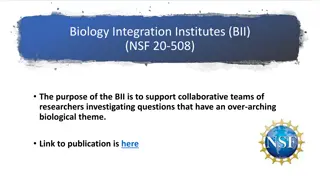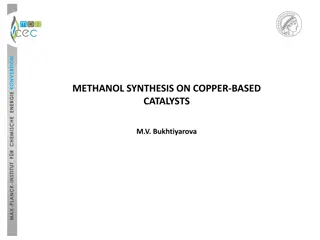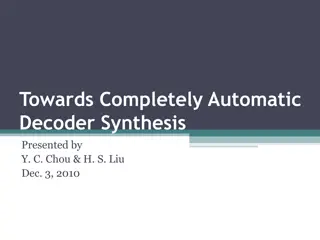Preparation of Aspirin: Overview and Synthesis Methods
The preparation of aspirin involves the synthesis of 2-acetyl salicylic acid, known for its therapeutic uses as an analgesic, antipyretic, and anti-inflammatory agent. This process includes the detailed characteristics, stability, mechanism, and synthesis methods of aspirin. Important considerations
0 views • 12 slides
Acetaminophen Synthesis Process Explained
Acetaminophen, also known as paracetamol, is a widely used analgesic and fever-reducing medicine. The synthesis of acetaminophen involves treating an amine with an acid anhydride to form an amide. This process includes mixing reactants, isolating crude acetaminophen, and purifying the final product.
0 views • 17 slides
Understanding the Thyroid Gland: Functions and Hormone Synthesis
The thyroid gland is a vital endocrine gland located below the larynx, responsible for producing thyroid hormones essential for regulating metabolism. This gland consists of follicles lined with follicular cells, producing thyroglobulin and thyroid hormones T3 and T4. Iodine plays a crucial role in
0 views • 40 slides
An Overview of Biological Databases in Bioinformatics
Biological databases play a crucial role in bioinformatics, storing vast amounts of data related to nucleotide sequences, protein sequences, and more. These databases are publicly accessible and essential for research in biological fields. Primary databases, such as GenBank, EMBL, and DDBJ, contain
0 views • 13 slides
Chemistry, Synthesis, Reactions, and Medicinal Uses of Pyridine & Azepine
Explore the fascinating world of pharmaceutical organic chemistry with a focus on Pyridine and Azepine. Learn about the chemistry, synthesis, reactions, and medicinal applications of these important compounds through a series of informative slides. Delve into the structural characteristics, synthesi
2 views • 23 slides
Overview of Heme Synthesis and Porphyrias
Heme is a crucial component present in various essential proteins in the body, such as hemoglobin, myoglobin, and cytochromes. The synthesis of heme takes place in multiple steps involving different organelles and enzymes in the cell. Porphyrias are a group of disorders related to heme synthesis, ch
0 views • 44 slides
Synthesis of Acetylcysteine: Procedure, Uses, and Precautions
The synthesis of acetylcysteine involves acetylating L-Cysteine in the presence of acetic anhydride and sulfuric acid. Acetylcysteine has various uses, including reducing pulmonary secretions' viscosity, being an antidote for acetaminophen overdose, and chelating heavy metals. The procedure, precaut
0 views • 20 slides
Endocrinological Aspects of Pregnancy: Hormones, Functions, and Synthesis
During pregnancy, endocrinological structures like the corpus luteum and placenta play vital roles in the production of hormones such as progesterone and estrogens. Progesterone maintains pregnancy by controlling essential functions like endometrial differentiation, myometrial quiescence, and local
4 views • 15 slides
Mechanism of Action of Antifolate Drugs in Bacterial Synthesis
Folate-derived cofactors are crucial for cell growth, with bacteria relying on de novo synthesis while humans need preformed folate. Antifolates like sulfonamides and trimethoprim disrupt folate synthesis in bacteria, inhibiting DNA synthesis. This article explores how these drugs target bacterial e
0 views • 34 slides
Understanding Hemoglobin: Synthesis, Functions, and Influence on Anemia
Hemoglobin is a vital protein in red blood cells responsible for oxygen transport. Its synthesis, influenced by factors like erythropoietin, vitamins, and trace metals, plays a crucial role in maintaining proper oxygen levels in the body. An insight into hemoglobin's structure, synthesis, and impact
3 views • 19 slides
Understanding Adrenergic Transmission and Catecholamine Synthesis
Adrenergic transmission involves the release of neurotransmitters such as norepinephrine, dopamine, and epinephrine at synapses or neuroeffector junctions. These neurotransmitters, known as catecholamines, play crucial roles in transmitting impulses in the sympathetic nervous system and central nerv
0 views • 14 slides
Chemistry, Synthesis, Reactions, and Medicinal Uses of Pyrimidine & Purine
Explore the fascinating world of pharmaceutical organic chemistry in Unit IV, focusing on the chemistry, synthesis, reactions, and medicinal applications of Pyrimidine and Purine compounds. Dive deep into the structures, properties, and pharmacological significance of these essential molecules throu
1 views • 15 slides
Understanding Protein Synthesis Process in Cells
Explore the key terms related to protein synthesis: RNA, mRNA, rRNA, tRNA, protein synthesis, transcription, translation, amino acid, codon, and anticodon. Understand the intricate process of protein formation through transcription and translation steps.
0 views • 11 slides
Overview of Amines Synthesis and Reactions
This educational content delves into the classification and synthesis of amines, focusing on the synthesis of aliphatic amines through various methods like reduction of nitro compounds, acid amides, and aldoximes. It also discusses important reactions such as the Hofmann degradation, Curtius reactio
0 views • 19 slides
Chemistry, Synthesis, Reactions, and Medicinal Uses of Oxazole & Thiazole
Explore the world of pharmaceutical organic chemistry in Unit IV, delving into the chemistry, synthesis, reactions, and medicinal applications of Oxazole and Thiazole. Gain insights into the structures, synthesis methods, and pharmacological significance of these important compounds through detailed
0 views • 18 slides
Understanding Summary, Analysis, and Synthesis in Academic Writing
Summary, analysis, and synthesis are essential components of academic writing. Summary involves restating information while analysis breaks down parts to understand the whole. Synthesis brings together ideas from different sources to create new insights. Each serves a unique purpose in creating well
0 views • 8 slides
Comprehensive Overview of Singer Voice Synthesis and Model Structures
Explore the world of controllable singing voice synthesis with natural language prompts. Understand the model structures for singing voice synthesis (SVS) and how text encoders extract semantic representations. Learn about training prompts, digital audio concepts, and audio codecs used for synthesiz
0 views • 19 slides
Understanding Biological Adversaries: Education Levels and Demographics
Exploring the traits of biological adversaries, this study reveals that perpetrators with higher education levels are more likely to successfully use chemical and biological agents. Success tends to increase with age and years of activity. Most individual perpetrators originate from the MENA region,
0 views • 16 slides
SAT-Based Exact Synthesis Using DAG Topology Families
Explore the world of exact synthesis in digital circuit design utilizing SAT solvers to achieve precise results. Understand the challenges, decision problems, algorithms, motivation behind exact synthesis, and the contribution of SAT solvers in mitigating runtime. Discover the concept of DAG topolog
0 views • 17 slides
Insights into Biological Synthesis Techniques and Related Work
Explore the biological synthesis project by Sumay and Sumit Gulwani at MSR Redmond. The project delves into template-based approaches and safety considerations in artifact synthesis. The outline covers inductive synthesis, challenges, and successes in achieving synthesis goals. Discover unique namin
0 views • 15 slides
Accounting for Biological Assets and Agricultural Produce
At the end of this lesson, you will be able to identify the principal issues in accounting for biological assets and agricultural produce at the time of harvest. Topics include the recognition, measurement, presentation, and disclosure of biological assets in financial statements. Questions regardin
0 views • 26 slides
Accounting for Biological Assets and Agricultural Produce (LKAS 41: Agriculture) by Rangajewa Herath
This content provides insights into the accounting standards for biological assets and agricultural produce under LKAS 41, discussing classification, presentation, measurement, gain or loss recognition, and disclosure requirements. It covers the unique nature of biological assets, the scope of LKAS
0 views • 20 slides
The Intricate Pathways of Choline Synthesis and Oxidation in Molecular Biology
Delve into the complex processes of choline synthesis and oxidation pathways, involving the integration of hydride ions and various molecules, essential for the production of phosphatidylcholine and other crucial compounds in biological systems. Learn about the enzymes and mechanisms that drive the
1 views • 11 slides
Exploring Physical Theatre and Gothic Themes in Teaching Synthesis
Workshop on teaching synthesis through physical theatre and Gothic themes. Learn about synthesising concepts, managing assessments independently, and incorporating subject content in learning. Discover methods for teaching synthesis and enhancing student learning experiences through drama activities
0 views • 26 slides
Reexamining the Biological Race Debate by Quayshawn Spencer
Quayshawn Spencer reexamines the biological race debate, discussing the onto-semantic strategy, its problems, and applications to public health genomics. The philosophical foundations of biological racial anti-realism are critiqued, exploring the concept of race through historical perspectives like
0 views • 37 slides
Biology Integration Institutes (BII) - NSF Research Opportunity
Supporting collaborative teams of researchers exploring overarching biological themes, the Biology Integration Institutes (BII) provide a framework for integrated research in diverse biological disciplines. This initiative enables design and development activities, with potential for significant fun
0 views • 10 slides
Automated Program Synthesis and Application in Game Programming
Exploring program synthesis as a method for automatic program construction to meet high-level specifications, focusing on applications in game programming. Discusses concepts like Church Synthesis, Computation Tree Logic (CTL), and real-life examples like Tic-Tac-Toe game strategy synthesis. Explore
0 views • 7 slides
Guide to UCSB Biological Safety Program
This guide provides an overview of UCSB's Biological Safety Program, covering important aspects such as lab safety fundamentals, biological use authorization, biosafety officer's role, and the Institutional Biosafety Committee. It outlines key steps like hazard assessment, training, waste management
0 views • 24 slides
Enzymes in Biological Reactions: Understanding Activation Energy
Enzymes, as biological catalysts, play a crucial role in regulating biological processes by lowering the activation energy required for chemical reactions in cells. The addition of enzymes changes the overall energy dynamics of reactions, impacting the rate at which products are formed. This interac
0 views • 7 slides
Automated String Processing in Spreadsheets: Innovations and Applications
Automating string processing in spreadsheets is gaining traction due to advancements in program synthesis technology. This field enables the generation of algorithms and programs from logic and examples, benefitting algorithm designers, software developers, and end-users alike. Synthesis techniques
0 views • 22 slides
Methanol Synthesis on Copper-Based Catalysts at Max Planck Institut
Methanol production using synthesis gas, studying CO2 hydrogenation for reduced CO2 emissions, and utilizing methanol as a hydrogen storage method are key areas of focus at the Max Planck Institut for Chemical Energy Conversion. The process involves methanol synthesis from CO2 and H2, with experimen
0 views • 19 slides
Advances in Completely Automatic Decoder Synthesis
This presentation by Y.C. Chou and H.S. Liu on "Towards Completely Automatic Decoder Synthesis" covers topics such as motivation, preliminary concepts, main algorithms, and experimental results in the field of communication and cryptography systems. The content delves into notation, SAT solvers, Cra
0 views • 35 slides
Role of RNA in Biological Processes and Protein Synthesis
Ribonucleic acid (RNA) is a crucial polymeric molecule in various biological functions including coding, decoding, gene regulation, and expression. It works alongside DNA and plays a key role in protein synthesis. There are three major types of RNA - rRNA, tRNA, and mRNA, each with specific function
0 views • 5 slides
Advancing Biological Data Standards for Marine Research
Discussion on biological data standards for marine research, challenges faced, existing standards, and the need for guidance and community building. Goals include maximizing data relevance for biodiversity studies. Ongoing work involves developing a primer for data managers unfamiliar with biologica
0 views • 7 slides
Understanding Purine Nucleotide Synthesis in Molecular Biology
The process of Purine Nucleotide Synthesis involves the formation of purine ribonucleotides, breakdown into uric acid, and the detailed steps of purine nucleotide synthesis. Key components like IMP, SAICAR, PRPP, and ATP play crucial roles in this complex metabolic pathway, offering insights into th
0 views • 22 slides
Understanding COMS and Recombinant DNA Regulations
The Committee on Microbiological Safety (COMS) was established in 1978 to address public concerns regarding safety, environment, and ethics of research involving hazardous biological agents. COMS oversees activities related to recombinant DNA and biological agents at Harvard, supporting all schools
0 views • 6 slides
Understanding Model-Based Projection Synthesis Theory and Practice
Explore the theory and practical application of Model-Based Projection Synthesis (MBP) in solving problems related to quantifier elimination, validity of first-order logic fragments, and witness synthesis. Learn about solving existential quantifier sentences and extracting witnesses in the context o
0 views • 56 slides
Understanding Statistics for Biological Data in Courses
Dive into the world of statistics for biological data through a comprehensive course led by experienced instructors at the University of Sheffield. Explore the fundamentals of statistics, research questions, hypotheses, and hypothesis testing related to biological inquiries. Gain insights into organ
0 views • 14 slides
Understanding Fatty Acid Metabolism in Animals
Animals cannot convert fatty acids into glucose due to the inability to synthesize glucose from fatty acids. The process involves acetyl-CoA not being converted into pyruvate or oxaloacetate, leading to the citric acid cycle and differences between fatty acid synthesis and degradation pathways. Key
0 views • 8 slides
Protein Synthesis Process Explained with Mrs. Griffiths
The protein synthesis process involves transcription where mRNA is made from DNA, followed by translation where tRNA molecules bring amino acids to assemble a polypeptide chain. This detailed explanation by Mrs. Griffiths covers the steps of DNA unwinding, mRNA formation, tRNA activation, ribosome a
0 views • 26 slides







































